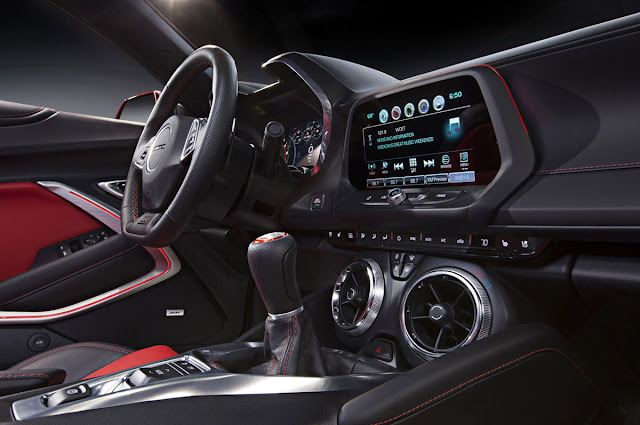The last Camaro was built on a stubby version of the Zeta platform, developed by Holden and meant to underpin full-size sedans like the Commodore, Pontiac G8 and the Chevy SS. The 2016 Camaro is derived from the Alpha rear-drive platform that debuted with the Cadillac ATS, something that's been compared favorably to a BMW 3-series in the handling department ever since launch.
The stated goal for this Camaro was to trim it down, and not just in the 200 pounds it apparently lost in the platform change. It looks thinner and more sporting, less like a two-door sedan and more of a genuine performance coupe. It's 2.3 inches shorter than the old model, about an inch lower and narrower, too.
Some might be disappointed it isn't enough of a departure from the looks popularized in the 2007 Transformers film, which sounds like a dated reference now. But the Camaro faithful probably won't mind, and in these photos, it looks much more svelte than before. RS and SS models get xenon lights and LED "signature strips" in front, while the base models make do with halogens.
Change is the story under the hood, however. A 2.0-liter turbo four from the ATS and CTS is the base engine now, producing 270 horsepower and 295 lb.-ft. of torque. GM says it's capable of 30 MPG on the highway, but with a 0-60 time of less than 6 seconds. It's substantially less powerful than the 2.3-liter turbo four Mustang Ecoboost, but that engine isn't the Ford's base powertrain.
Camaro buyers who want more than a four, no matter how torquey, will be offered an upgrade to a new 3.6-liter V6 with 330 horsepower, up slightly over the outgoing 3.6 base engine. It's a new design that will also be available in the 2016 Cadillac CT6 sedan.
But traditional muscle car fans will look to the 2016 Camaro SS and its 6.2-liter LT1 V8 out of the Corvette. Here it makes a stout 455 horsepower with either a six-speed manual or an eight-speed automatic – as the other two engines will be. The Camaro SS gets modern tricks to go with its old-fashioned brawn, too, in the form of magnetic ride control and Brembo brakes (optional on other models). Selectable driving modes will make their way onto the Camaro line for the first time. And the company says the SS will be capable of better lap times than the old 1LE could manage. The SS manual also gets a new rev-match system to make those downshifts smoother.
While it's still awash in retro touches, the interior is meant to be far more up-to-date and technically advanced, according to the Camaro's designers. A new configurable 8-inch dash display can be added in addition the one sitting in the center stack for the infotainment system. Heating controls have been simplified and classed-up a bit here. There's also an electronic parking brake, which will undoubtedly upset purists, but now apparently makes it so you won't knock anything out of the cupholder when shifting.
Also new is something called Interior Spectrum Lighting, which sounds a bit like a disco club. It allows for, "24 different ambient lighting effects on the dash, door panels, and center console," according to the release. So the Camaro hasn't lost its way inside, either.
Chevy noted in its release the first Camaro was shown on September 12, 1966, launched as a direct assault on the success Ford had with the Mustang. The rivalry lasted a few oil crises and 35 years until GM pulled the Camaro after its fourth generation in 2002. But since its initial discontinuation, rumors persisted about a new GM pony car and were made real in May 2009, when the fifth-generation went into production.










No comments:
Post a Comment